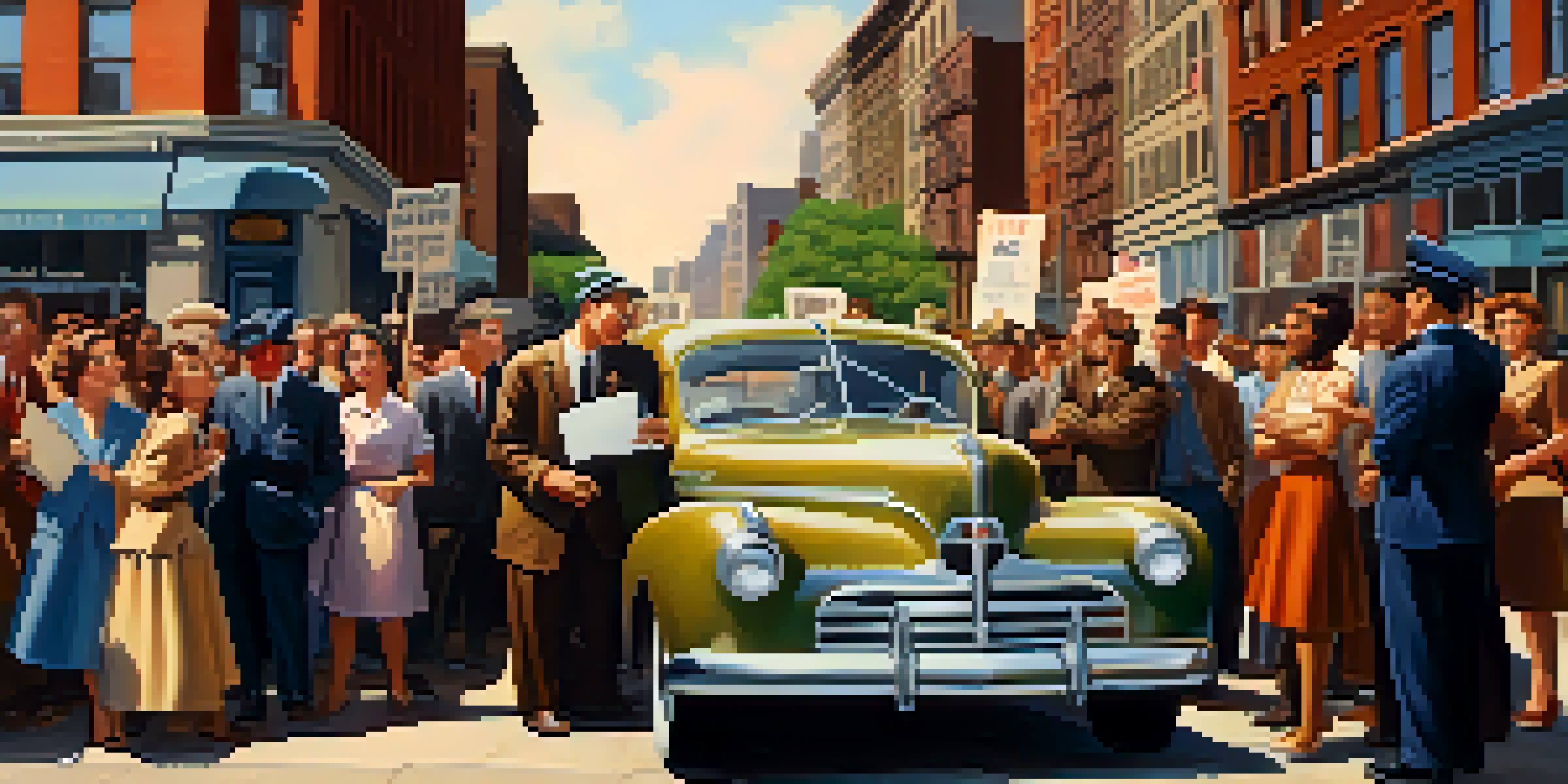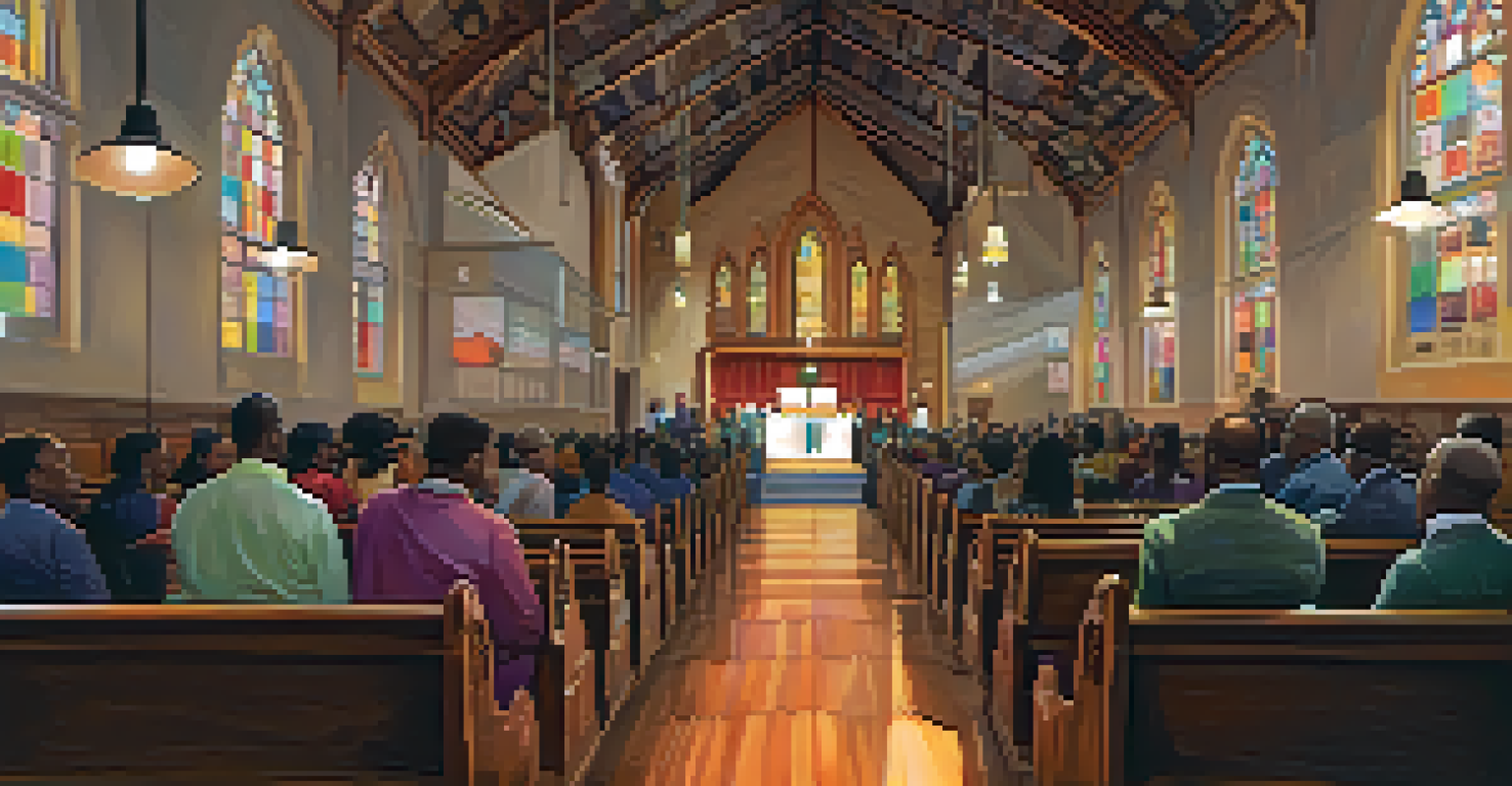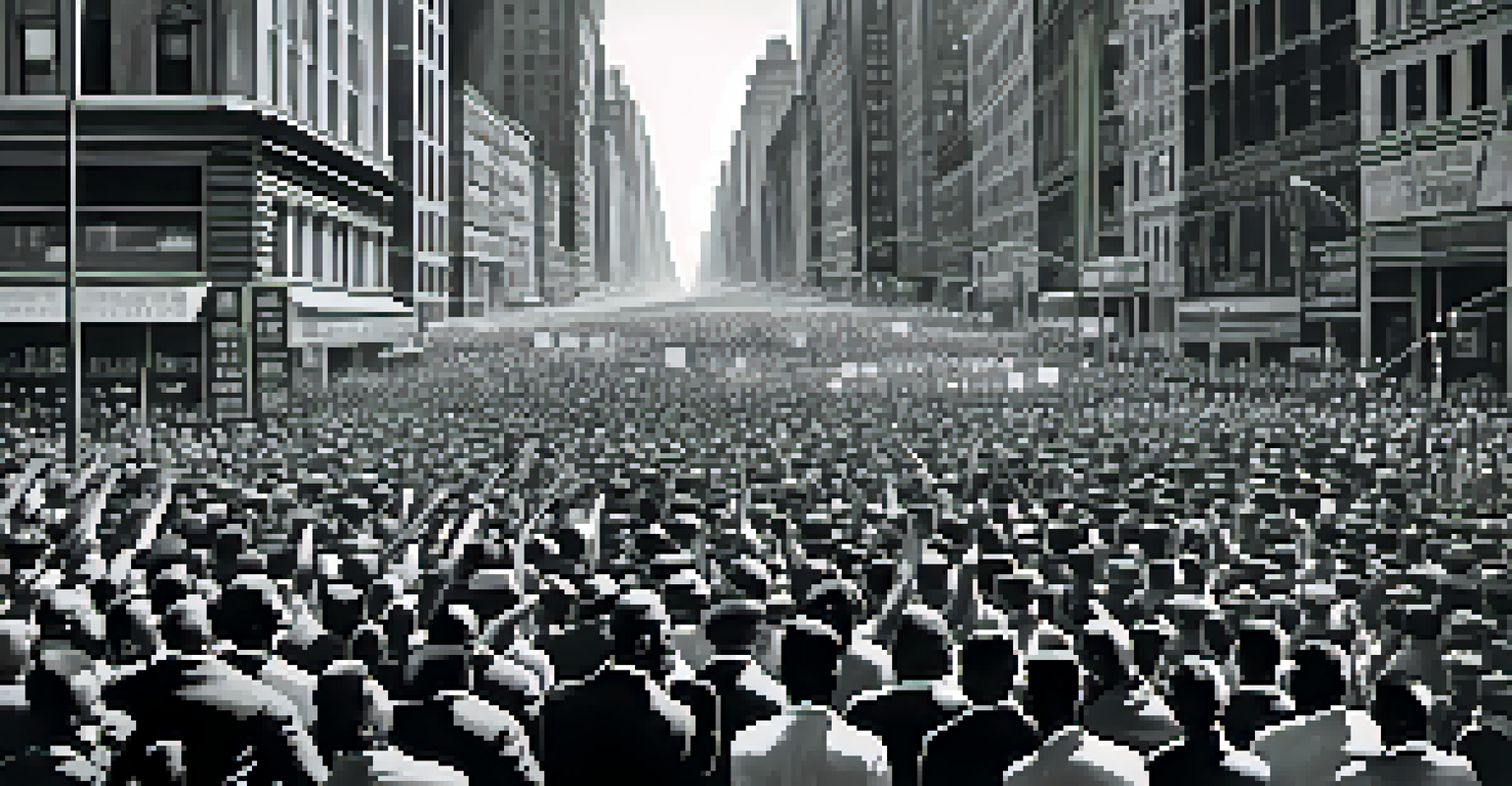Civil Rights Movement: NYC's Contribution to Racial Equality

The Early Seeds of Change: NYC in the 1940s
In the 1940s, New York City became a hotbed for civil rights activism as various organizations began advocating for racial equality. Groups like the National Association for the Advancement of Colored People (NAACP) and the Urban League worked tirelessly to combat discrimination and promote social justice. Their efforts laid the groundwork for the larger Civil Rights Movement that would sweep across the nation in the following decades.
Injustice anywhere is a threat to justice everywhere.
During this time, NYC was also home to a diverse population, which contributed to a rich tapestry of cultural exchange. Activists from different backgrounds collaborated, sharing ideas and strategies that would later influence movements beyond the city. This melting pot of perspectives allowed for a more nuanced approach to civil rights issues, which was crucial for fostering unity among various racial groups.
As tensions mounted in the post-war era, the city's vibrant artistic community played a key role in raising awareness. Writers, musicians, and artists used their platforms to highlight social injustices, mobilizing public opinion in favor of civil rights. This cultural momentum helped to amplify the voices of those demanding change, setting the stage for more organized efforts in the years to come.
The Harlem Renaissance: A Cultural Revolution
The Harlem Renaissance of the 1920s and 30s was a pivotal moment for African American culture in NYC, fostering pride and identity through art, music, and literature. Figures like Langston Hughes and Zora Neale Hurston not only entertained but also challenged societal norms, advocating for racial equality through their work. This cultural awakening laid the foundation for future civil rights activism by instilling a sense of empowerment among Black Americans.

Harlem became a hub for intellectual and artistic expression, igniting discussions about race and equality. The movement encouraged a new generation of activists who were inspired by the boldness of their predecessors. The cultural legacy of this era played a crucial role in shaping the narrative of the Civil Rights Movement, encouraging individuals to rally for their rights.
NYC's Role in Civil Rights Activism
In the 1940s, NYC became a vital hub for civil rights activism, with organizations like the NAACP and Urban League laying the groundwork for racial equality.
Moreover, the Harlem Renaissance helped to challenge stereotypes about African Americans, showcasing their talents and contributions to society. This shift in perception was essential for garnering support from allies within and outside the community, further energizing the fight for civil rights. The spirit of this cultural revolution would echo through the decades, influencing the strategies and goals of civil rights leaders in the 1960s.
Key Figures: NYC's Civil Rights Leaders
New York City was home to many influential figures in the Civil Rights Movement, such as A. Philip Randolph and Bayard Rustin. Randolph, known for organizing the 1963 March on Washington, tirelessly advocated for labor rights and racial equality. His leadership not only mobilized thousands but also highlighted the intersectionality of race and economic justice, a theme that resonated deeply throughout the movement.
The time is always right to do what is right.
Bayard Rustin, often overshadowed due to his sexuality, played a critical role in shaping the logistics of civil rights demonstrations. His organizational skills and strategic insight were instrumental in planning major events that drew national attention to the cause. Rustin's contributions remind us that many leaders worked behind the scenes, ensuring that the fight for equality remained focused and impactful.
These leaders, along with many others from NYC, served as mentors to younger activists, forging connections across various social movements. Their commitment to civil rights and social justice inspired generations to continue the fight for equality. The legacy of these key figures remains a vital part of NYC's contribution to the broader struggle for racial justice.
The Role of Institutions: Churches and Organizations
Throughout the Civil Rights Movement, churches and community organizations in NYC served as essential support systems for activists. Places like the Abyssinian Baptist Church became organizing hubs where leaders could gather, strategize, and mobilize community members. These institutions not only provided a space for meetings but also offered spiritual guidance and a sense of solidarity among activists.
Organizations such as the Congress of Racial Equality (CORE) and the Student Nonviolent Coordinating Committee (SNCC) established strong roots in NYC, organizing protests and educational campaigns. Their initiatives focused on addressing local issues like housing discrimination and police brutality, which were critical to advancing civil rights. This localized approach helped to galvanize support and raise awareness about systemic injustices.
Cultural Impact of the Harlem Renaissance
The Harlem Renaissance empowered African American identity and creativity, fostering a cultural revolution that inspired future civil rights movements.
Additionally, the collaboration between religious institutions and civil rights organizations fostered a sense of community engagement. This partnership encouraged individuals from different backgrounds to unite in the fight against injustice, reinforcing the idea that everyone has a role to play in the pursuit of equality. The collective efforts of these entities had a lasting impact on the movement, demonstrating the power of grassroots activism.
Protests and Marches: NYC Takes to the Streets
New York City was the site of numerous protests and marches during the Civil Rights Movement, showcasing the determination of its residents to advocate for racial equality. Events like the 1964 Civil Rights March on City Hall drew thousands, demanding an end to segregation and discrimination. These demonstrations not only amplified the voices of marginalized communities but also put pressure on local officials to enact change.
The visibility of these protests played a crucial role in raising awareness about civil rights issues nationwide. Media coverage of the events captured the passion and commitment of participants, inspiring similar movements across the country. The images of diverse groups standing together in solidarity became iconic symbols of the struggle for equality, further galvanizing public support.
Moreover, these actions often sparked conversations within the community about the importance of civil rights. They served as powerful reminders that change requires collective effort and courage. The legacy of these marches continues to inspire new generations to engage in activism, emphasizing the importance of standing up for justice.
Education and Awareness: NYC's Commitment to Change
In the fight for racial equality, education emerged as a powerful tool for change in New York City. Activists recognized that raising awareness about civil rights issues was essential for fostering a more informed and engaged public. Community workshops, lectures, and educational programs were organized to discuss the significance of the movement and its impact on society.
Schools and universities also played a critical role in promoting civil rights education. Institutions like City University of New York (CUNY) became platforms for politically active students who sought to address issues of racial inequality. This academic engagement not only empowered students but also encouraged them to take action within their communities.
Enduring Legacy of NYC Activists
The contributions of NYC's civil rights leaders continue to influence contemporary social justice movements, highlighting the importance of collective action.
The commitment to education and awareness in NYC laid the groundwork for future generations of activists. By equipping individuals with knowledge about their rights and the history of the civil rights struggle, the city fostered a culture of advocacy. Today, this legacy continues to shape discussions around social justice, inspiring ongoing efforts to combat inequality.
The Lasting Impact: NYC's Legacy in the Civil Rights Movement
New York City's contributions to the Civil Rights Movement have left a lasting impact on the fight for racial equality. The city's diverse population and rich cultural history fostered an environment where activism could thrive. The strategies developed and the alliances formed during this time continue to influence contemporary movements for social justice.
Moreover, the lessons learned from NYC's civil rights activists are applicable to various social issues today. The emphasis on intersectionality and community engagement serves as a blueprint for current movements addressing systemic inequality. As activists adapt these approaches, they honor the legacy of those who fought for change in NYC and beyond.

Ultimately, NYC's role in the Civil Rights Movement is a testament to the power of collective action and resilience. The spirit of activism that flourished in the city continues to inspire new generations to advocate for equality and justice. As we reflect on this history, it is essential to recognize the ongoing work needed to realize the dream of a truly equitable society.